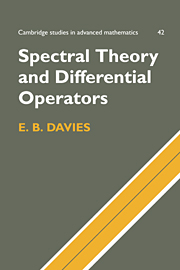1 - The fundamental ideas
Published online by Cambridge University Press: 08 January 2010
Summary
Unbounded linear operators
One of the key notions in any introductory course on functional analysis is that of a bounded linear operator. If A is such an operator on the Banach space ℬ then there is a closed bounded subset Spec(A) of the complex plane called its spectrum. The proof that the spectrum is always non-empty is rather indirect, and this is related to the fact that the explicit determination of the spectrum of particular operators is often very difficult.
In this chapter we describe the appropriate context in which one can define and analyse the spectrum of unbounded linear operators, particularly those which are closed or self-adjoint. The description of the spectrum of particular operators will be the main focus of attention throughout the book.
Before one can start to study a differential operator one has to choose the Banach or Hilbert space in which it acts; we mention here that all Banach and Hilbert spaces in the book are assumed to be complex. It turns out that the spectrum of an operator can change depending upon the Banach space in which it acts. There is, however, another problem, namely that differential operators are unbounded when considered as acting on any of the usual Banach or Hilbert spaces. Because of this we cannot even start to study them until we have given a more general definition of a linear operator.
The key to this new definition is to drop the requirement that the domain of the operator is the whole of the Banach space in which the operator acts, and allow it to be a dense linear subspace.
- Type
- Chapter
- Information
- Spectral Theory and Differential Operators , pp. 1 - 21Publisher: Cambridge University PressPrint publication year: 1995

